snow chains MITSUBISHI ECLIPSE CROSS 2018 Owner's Manual (in English)
[x] Cancel search | Manufacturer: MITSUBISHI, Model Year: 2018, Model line: ECLIPSE CROSS, Model: MITSUBISHI ECLIPSE CROSS 2018Pages: 417, PDF Size: 74.06 MB
Page 202 of 417
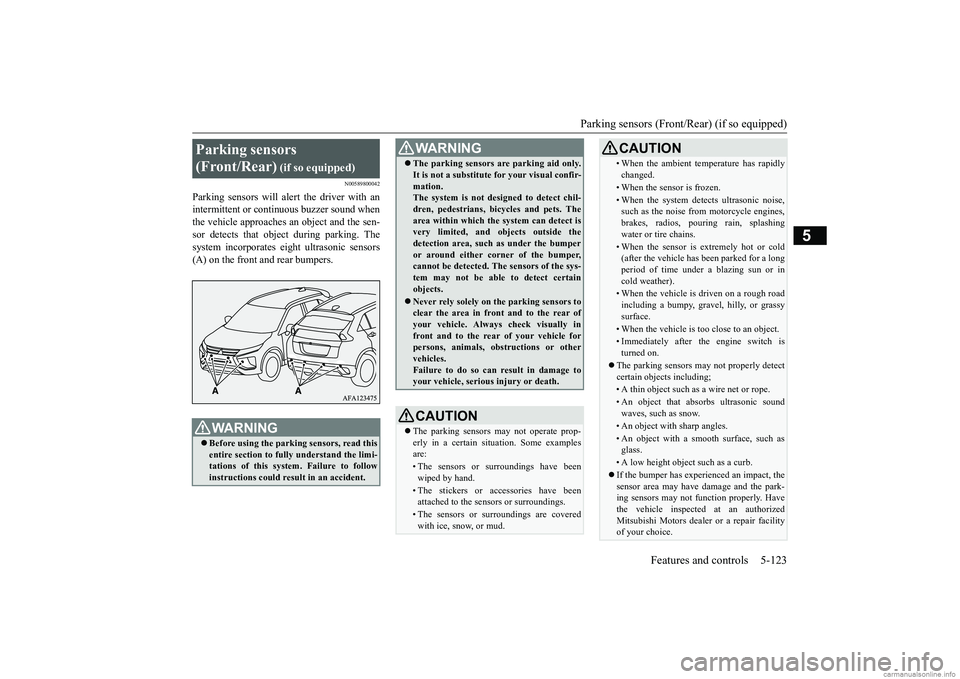
Parking sensors (Front/Rear) (if so equipped)
Features and controls 5-123
5
N00589800042
Parking sensors will alert the driver with an intermittent or continuous buzzer sound whenthe vehicle approaches an object and the sen- sor detects that object during parking. The system incorporates eight ultrasonic sensors(A) on the front and rear bumpers.Parking sensors (Front/Rear)
(if so equipped)
WA R N I N G Before using the parking sensors, read this entire section to fully understand the limi-tations of this system. Failure to follow instructions could result in an accident.
The parking sensors are parking aid only. It is not a substitute for your visual confir- mation. The system is not designed to detect chil- dren, pedestrians, bicycles and pets. Thearea within which the system can detect is very limited, and ob
jects outside the
detection area, such as under the bumperor around either corner of the bumper, cannot be detected. The sensors of the sys- tem may not be able to detect certainobjects. Never rely solely on the parking sensors to clear the area in front and to the rear of your vehicle. Always check visually in front and to the rear of your vehicle forpersons, animals, obstructions or other vehicles. Failure to do so can result in damage toyour vehicle, serious injury or death.CAUTION The parking sensors may not operate prop- erly in a certain situation. Some examples are:• The sensors or surroundings have beenwiped by hand.• The stickers or accessories have beenattached to the sensors or surroundings.• The sensors or surroundings are coveredwith ice, snow, or mud.WA R N I N G
• When the ambient temperature has rapidly changed.• When the sensor is frozen.• When the system detects ultrasonic noise,such as the noise from motorcycle engines, brakes, radios, pouring rain, splashingwater or tire chains.• When the sensor is extremely hot or cold(after the vehicle has been parked for a long period of time under a blazing sun or in cold weather).• When the vehicle is driven on a rough roadincluding a bumpy, gravel, hilly, or grassysurface.• When the vehicle is too close to an object.• Immediately after the engine switch isturned on.
The parking sensors may not properly detect certain objects including;• A thin object such as a wire net or rope.• An object that absorbs ultrasonic sound waves, such as snow.• An object with sharp angles.• An object with a smooth surface, such as glass.• A low height object such as a curb. If the bumper has experienced an impact, the sensor area may have damage and the park- ing sensors may not function properly. Have the vehicle inspected at an authorizedMitsubishi Motors dealer or a repair facility of your choice.CAUTION
BK0252700US.book
123 ページ 2017年10月4日 水曜日 午後4時54分
Page 350 of 417
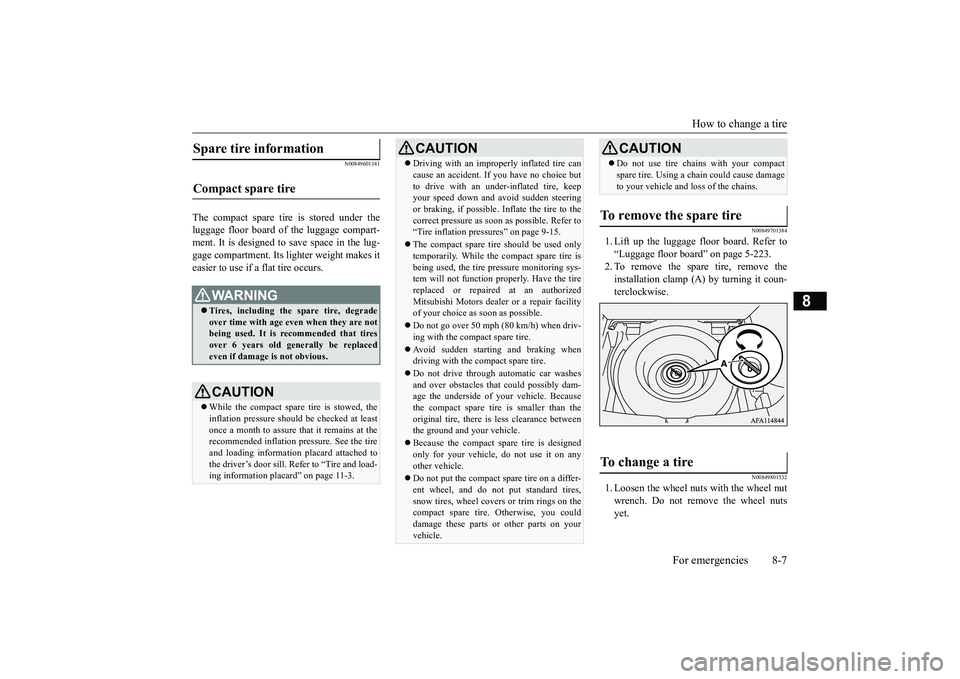
How to change a tire
For emergencies 8-7
8
N00849601341
The compact spare tire is stored under the luggage floor board of the luggage compart-ment. It is designed to save space in the lug- gage compartment. Its lighter weight makes it easier to use if a flat tire occurs.
N00849701384
1. Lift up the luggage floor board. Refer to“Luggage floor board” on page 5-223.2. To remove the spare tire, remove theinstallation clamp (A) by turning it coun- terclockwise.
N00849801532
1. Loosen the wheel nuts with the wheel nut wrench. Do not remove the wheel nuts yet.
Spare tire information Compact spare tire
WA R N I N G Tires, including the spare tire, degrade over time with age even when they are notbeing used. It is recommended that tires over 6 years old generally be replaced even if damage is not obvious.CAUTION While the compact spare tire is stowed, the inflation pressure should be checked at least once a month to assure that it remains at therecommended inflation pressure. See the tire and loading information placard attached to the driver’s door sill. Refer to “Tire and load- ing information placard” on page 11-3.
Driving with an improperly inflated tire can cause an accident. If you have no choice but to drive with an under-inflated tire, keep your speed down and avoid sudden steering or braking, if possible
. Inflate the tire to the
correct pressure as soon as possible. Refer to “Tire inflation pressures” on page 9-15. The compact spare tire should be used only temporarily. While the compact spare tire is being used, the tire pressure monitoring sys-tem will not function properly. Have the tire replaced or repaired at an authorized Mitsubishi Motors dealer or a repair facilityof your choice as soon as possible. Do not go over 50 mph (80 km/h) when driv- ing with the compact spare tire. Avoid sudden starting and braking when driving with the compact spare tire. Do not drive through automatic car washes and over obstacles that could possibly dam- age the underside of your vehicle. Because the compact spare tire is smaller than theoriginal tire, there is less clearance between the ground and your vehicle. Because the compact spare tire is designed only for your vehicle, do not use it on any other vehicle. Do not put the compact spare tire on a differ- ent wheel, and do not put standard tires, snow tires, wheel covers or trim rings on the compact spare tire. Otherwise, you coulddamage these parts or other parts on your vehicle.CAUTION
Do not use tire chains with your compact spare tire. Using a chain could cause damage to your vehicle and loss of the chains.
To remove the spare tire To change a tire
CAUTION
BK0252700US.bo
ok 7 ページ 2017年10月4日 水曜日 午後4時54分
Page 356 of 417
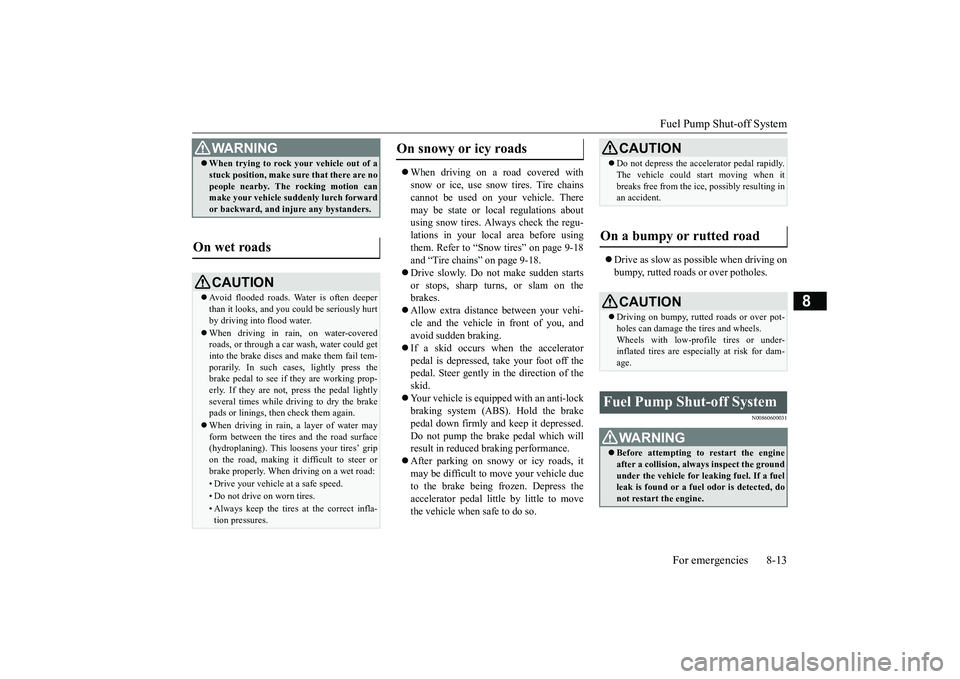
Fuel Pump Shut-off System
For emergencies 8-13
8
When driving on a road covered with snow or ice, use snow tires. Tire chains cannot be used on your vehicle. Theremay be state or local regulations about using snow tires. Always check the regu- lations in your local area before usingthem. Refer to “Snow tires” on page 9-18 and “Tire chains” on page 9-18. Drive slowly. Do not make sudden starts or stops, sharp turns, or slam on thebrakes. Allow extra distance between your vehi- cle and the vehicle in front of you, andavoid sudden braking. If a skid occurs when the accelerator pedal is depressed, take your foot off thepedal. Steer gently in the direction of the skid. Your vehicle is equipped with an anti-lock braking system (ABS). Hold the brake pedal down firmly and keep it depressed. Do not pump the brake pedal which willresult in reduced braking performance. After parking on snowy or icy roads, it may be difficult to move your vehicle dueto the brake being frozen. Depress the accelerator pedal little by little to move the vehicle when safe to do so.
Drive as slow as poss
ible when driving on
bumpy, rutted roads or over potholes.
N00860600031
WA R N I N G When trying to rock your vehicle out of a stuck position, make sure that there are no people nearby. The rocking motion can make your vehicle suddenly lurch forward or backward, and injure any bystanders.
On wet roads
CAUTION Avoid flooded roads. Water is often deeper than it looks, and you could be seriously hurt by driving into flood water. When driving in rain, on water-covered roads, or through a car wash, water could getinto the brake discs and make them fail tem- porarily. In such cases, lightly press the brake pedal to see if they are working prop-erly. If they are not, press the pedal lightly several times while driving to dry the brake pads or linings, then check them again. When driving in rain, a layer of water may form between the tires and the road surface(hydroplaning). This loosens your tires’ grip on the road, making it difficult to steer or brake properly. When driving on a wet road:• Drive your vehicle at a safe speed.• Do not drive on worn tires.• Always keep the tires at the correct infla- tion pressures.
On snowy or icy roads
CAUTION Do not depress the accelerator pedal rapidly. The vehicle could start moving when it breaks free from the ice, possibly resulting in an accident.
On a bumpy or rutted road
CAUTION Driving on bumpy, rutted roads or over pot- holes can damage the tires and wheels. Wheels with low-profile tires or under- inflated tires are especially at risk for dam-age.
Fuel Pump Shut-off System
WA R N I N G Before attempting to restart the engine after a collision, always inspect the ground under the vehicle for leaking fuel. If a fuel leak is found or a fuel odor is detected, donot restart the engine.
BK0252700US.bo
ok 13 ページ 2017年10月4日 水曜日 午後4時54分
Page 375 of 417
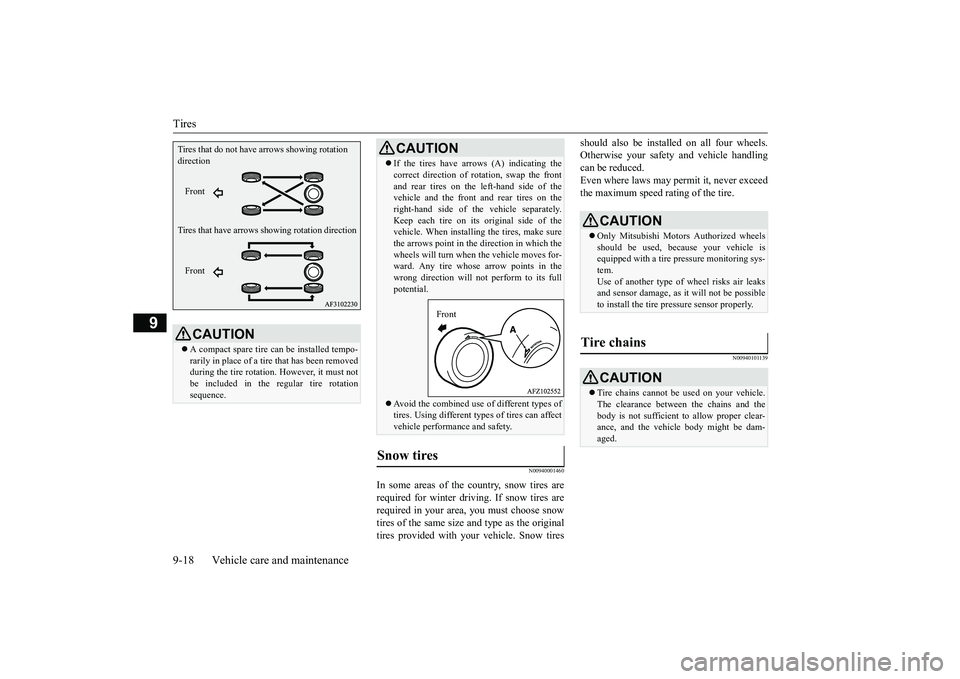
Tires
9-18 Vehicle care and maintenance
9
N00940001460
In some areas of the country, snow tires are
required for winter driving. If snow tires are
required in your area, you must choose snow
tires of the same size and type as the original
tires provided with your vehicle. Snow tiresshould also be installed on all four wheels.
Otherwise your safety and vehicle handling
can be reduced.
Even where laws may permit it, never exceed
the maximum speed rating of the tire.
N00940101139
CAUTION
A compact spare tire can be installed tempo-
rarily in place of a tire that has been removed
during the tire rotation. However, it must not
be included in the regular tire rotation
sequence.Tires that do not have arrows showing rotation
direction
Tires that have arrows showing rotation direction
Front
Front
If the tires have arrows (A) indicating the
correct direction of rotation, swap the front
and rear tires on the left-hand side of the
vehicle and the front and rear tires on the
right-hand side of the vehicle separately.
Keep each tire on its original side of the
vehicle. When installing the tires, make sure
the arrows point in the direction in which the
wheels will turn when the vehicle moves for-
ward. Any tire whose arrow points in the
wrong direction will not perform to its full
potential.Avoid the combined use of different types of
tires. Using different types of tires can affect
vehicle performance and safety.Snow tires
CAUTION
Front
CAUTIONOnly Mitsubishi Motors Authorized wheels
should be used, because your vehicle is
equipped with a tire pressure monitoring sys-
tem.
Use of another type of wheel risks air leaks
and sensor damage, as it will not be possible
to install the tire pressure sensor properly.Tire chains
CAUTIONTire chains cannot be used on your vehicle.
The clearance between the chains and the
body is not sufficient to allow proper clear-
ance, and the vehicle body might be dam-
aged.
BK0252700US.bo ok 18 ページ 2017年10月5日 木曜日 午後6時49分
Page 416 of 417
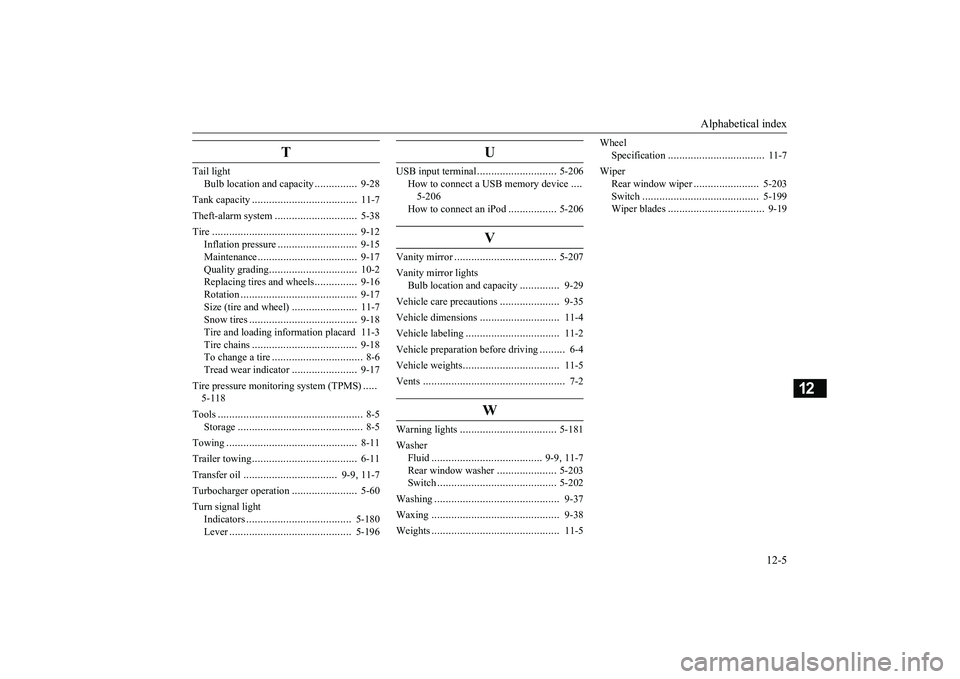
Alphabetical index
12-5
12
T
Tail light
Bulb location and capacity
...............
9-28
Tank capacity
....................
.................
11-7
Theft-alarm system
.............................
5-38
Tire
...........................
........................
9-12
Inflation pressure
............................
9-15
Maintenance
..................
.................
9-17
Quality grading
...............................
10-2
Replacing tires and wheels
...............
9-16
Rotation
....................
.....................
9-17
Size (tire and wheel)
.......................
11-7
Snow tires
.....................
.................
9-18
Tire and loading information placard 11-3 Tire chains
....................
.................
9-18
To change a tire
................
................
8-6
Tread wear indicator
.......................
9-17
Tire pressure monitoring system (TPMS)
.....
5-118 Tools
.........................
..........................
8-5
Storage
.........................
...................
8-5
Towing
......................
........................
8-11
Trailer towing
....................
.................
6-11
Transfer oil
................
.................
9-9
, 11-7
Turbocharger operation
.......................
5-60
Turn signal light
Indicators
..................
...................
5-180
Lever
........................
...................
5-196
U
USB input terminal
............................
5-206
How to connect a USB memory device
....
5-206 How to connect an iPod
.................
5-206
V
Vanity mirror
...................
.................
5-207
Vanity mirror lights
Bulb location and capacity
..............
9-29
Vehicle care precautions
.....................
9-35
Vehicle dimensions
............................
11-4
Vehicle labeling
..................
...............
11-2
Vehicle preparation before driving
.........
6-4
Vehicle weights
...................
...............
11-5
Vents
..........................
........................
7-2
W
Warning lights
.................
.................
5-181
Washer
Fluid
....................
...................
9-9
, 11-7
Rear window washer
.....................
5-203
Switch
.....................
.....................
5-202
Washing
......................
......................
9-37
Waxing
.......................
......................
9-38
Weights
.......................
......................
11-5
Wheel
Specification
.................
.................
11-7
Wiper
Rear window wiper
.......................
5-203
Switch
......................
...................
5-199
Wiper blades
.................
.................
9-19
BK0252700US.bo
ok 5 ページ 2017年10月4日 水曜日 午後4時54分